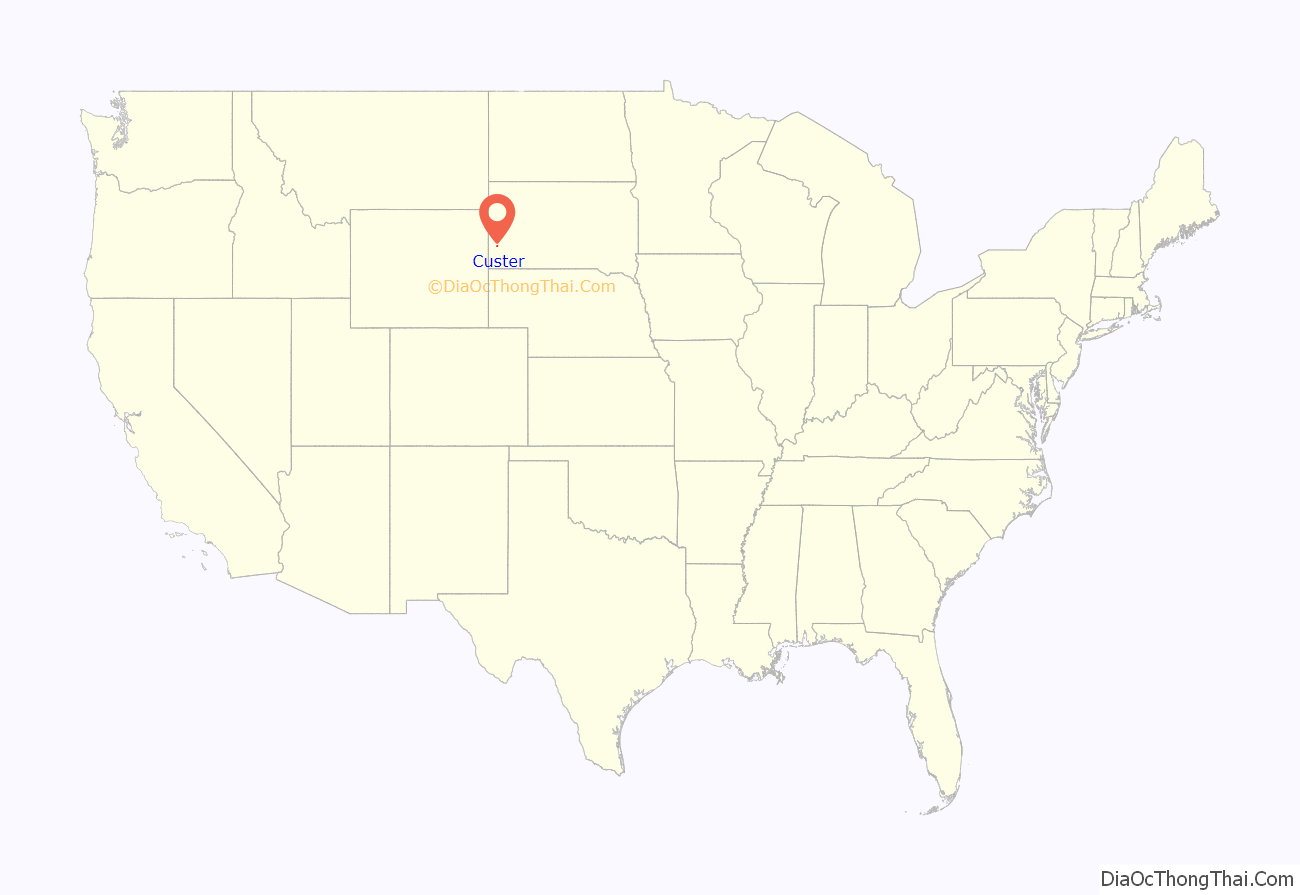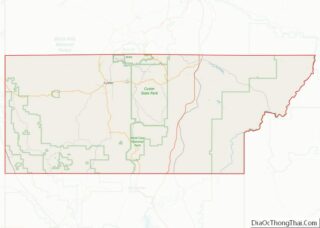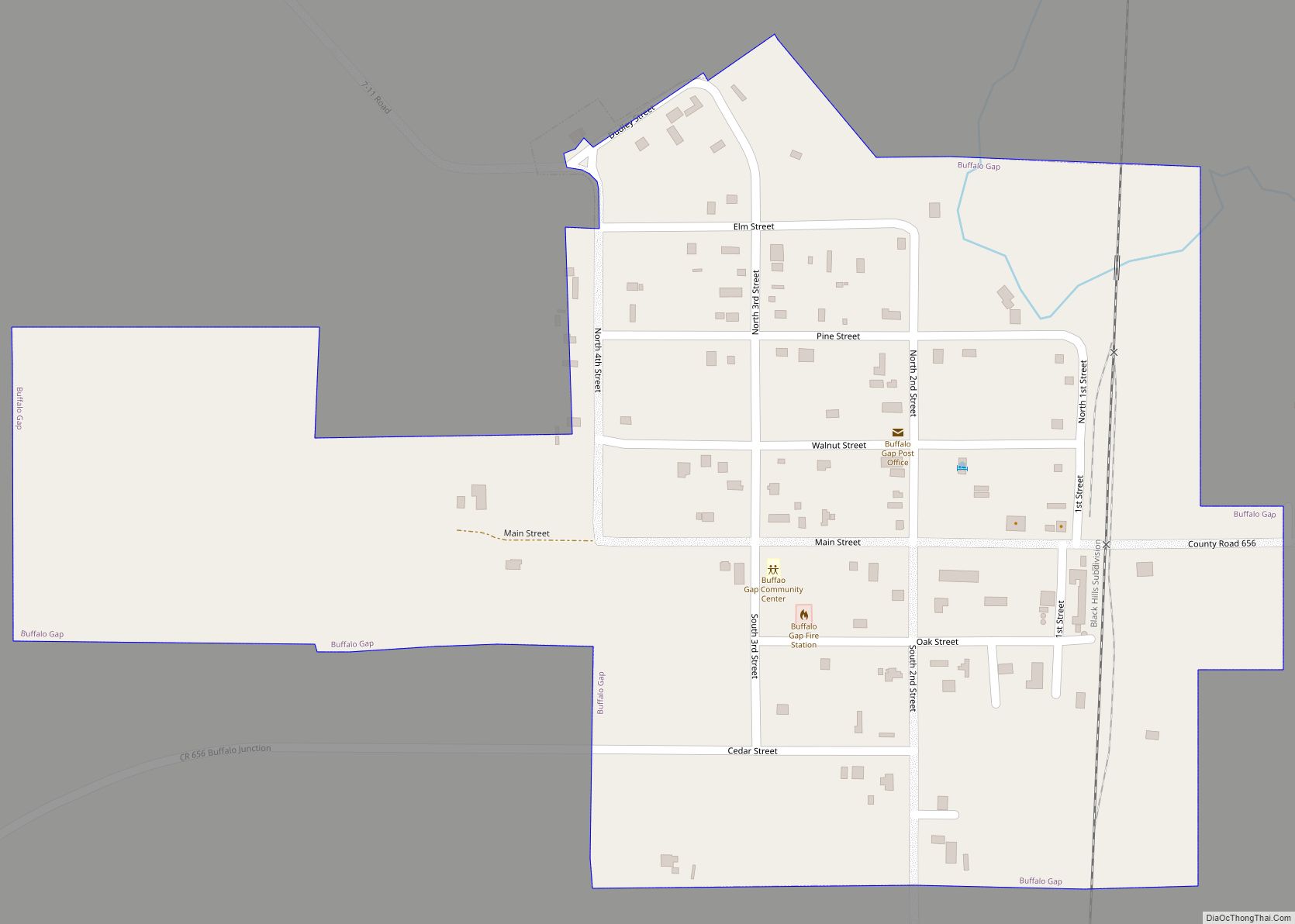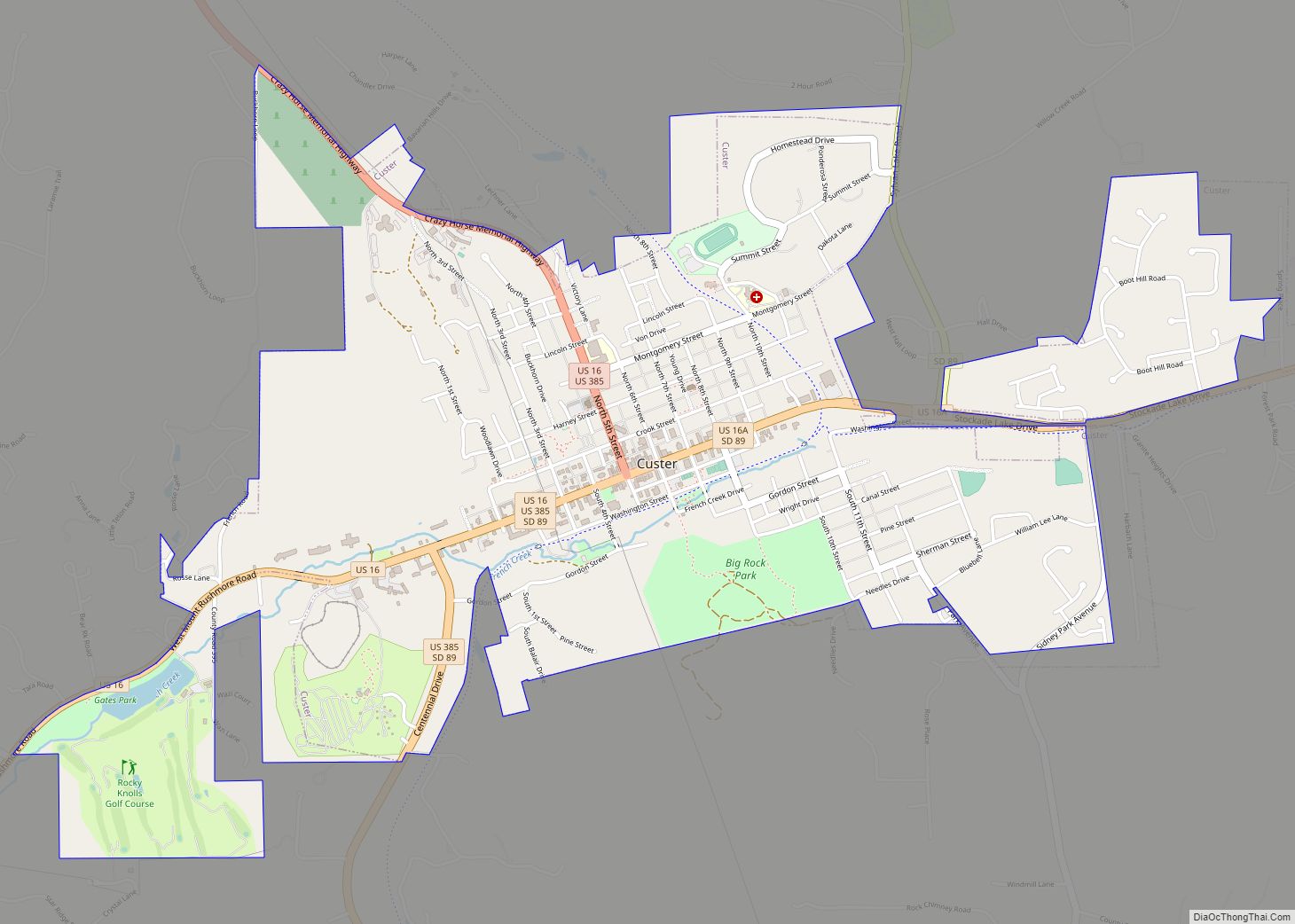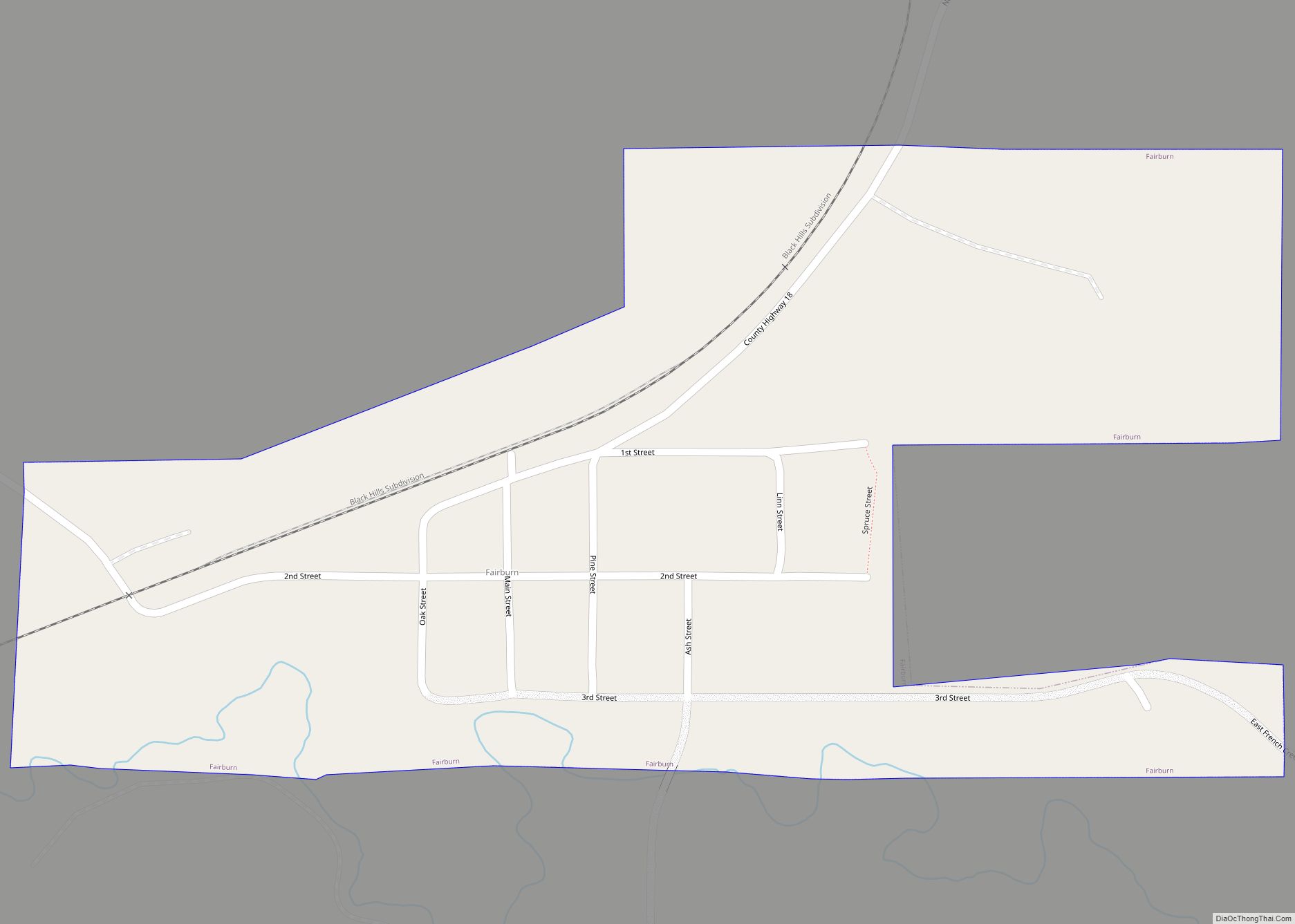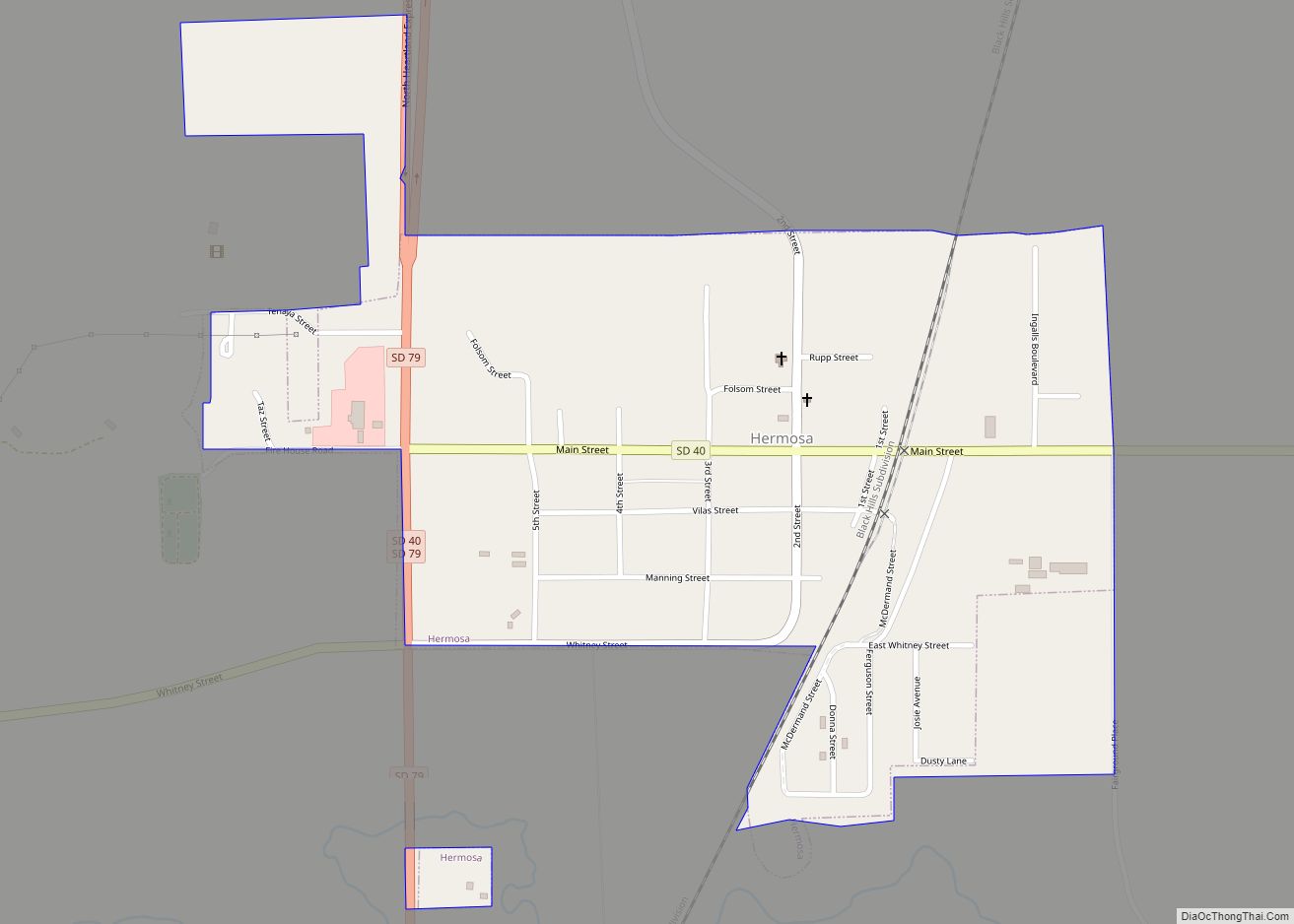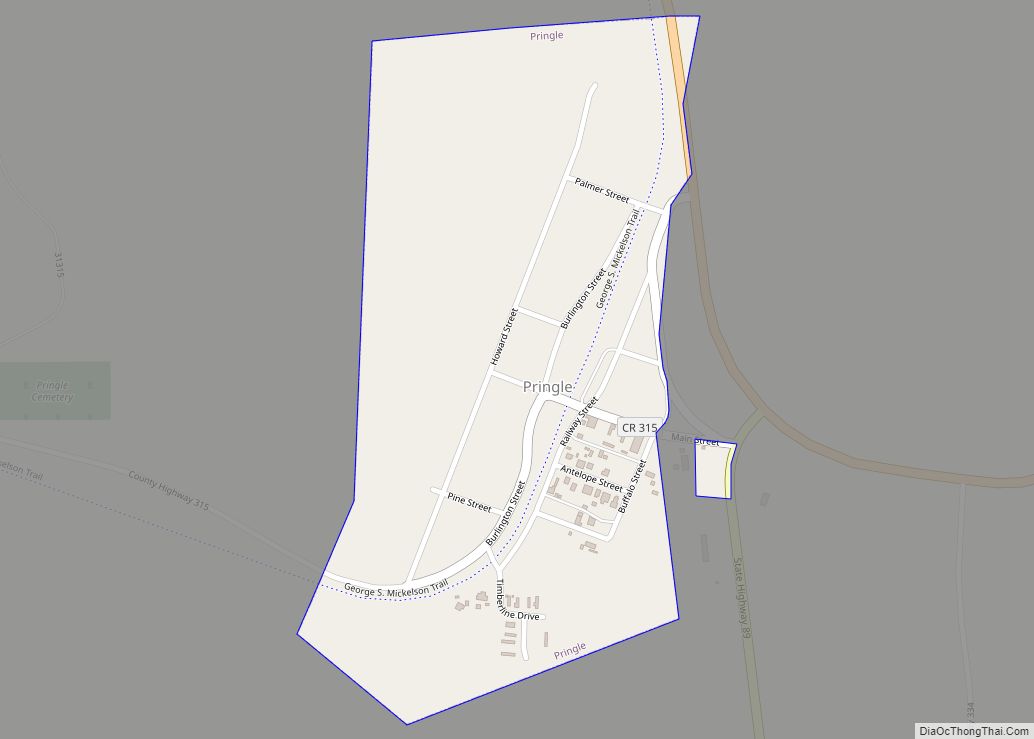Custer is a city in Custer County, South Dakota, United States. The population was 1,919 at the 2020 census. It is the county seat of Custer County.
| Name: | Custer city |
|---|---|
| LSAD Code: | 25 |
| LSAD Description: | city (suffix) |
| State: | South Dakota |
| County: | Custer County |
| Founded: | 1875 |
| Elevation: | 5,315 ft (1,620 m) |
| Total Area: | 2.54 sq mi (6.58 km²) |
| Land Area: | 2.53 sq mi (6.55 km²) |
| Water Area: | 0.01 sq mi (0.03 km²) |
| Total Population: | 1,919 |
| Population Density: | 758.50/sq mi (292.81/km²) |
| Area code: | 605 |
| FIPS code: | 4615140 |
| GNISfeature ID: | 1265633 |
Online Interactive Map
Click on ![]() to view map in "full screen" mode.
to view map in "full screen" mode.
Custer location map. Where is Custer city?
History
Custer is the oldest town established by European Americans in the Black Hills. Gold was discovered east of Custer during the Black Hills Expedition, conducted by the 7th Cavalry led by Lt. Colonel George Armstrong Custer, a discovery which initiated the Black Hills Gold Rush.
For thousands of years, the Black Hills had been part of the territory of varying tribes of indigenous peoples. They were within historical territory of the Oglala Sioux at the time of United States encounter, and within the Great Sioux Reservation established by the US Treaty of Fort Laramie (1868). Having established dominance in the area by the eighteenth century, the Oglala Sioux had long considered the Black Hills as sacred land.
After increasing encroachment by Americans and violent confrontations, the U.S. government forced the Sioux to cede much of the Black Hills in 1877, and opened the land for individual purchase and settlement. In 1875 trespassing gold-boomers named their settlement Stonewall (after the Confederate general, Stonewall Jackson), but it was renamed for Custer. Almost abandoned in 1876 after word of the much larger gold strikes in Deadwood Gulch spread, Custer later became an established city.
Custer has had a smaller population and been less wealthy than the Northern Hills cities of Deadwood and Lead. In addition to gold, Custer and other cities based their economies on the extraction of industrial minerals, which are still important to the regional economy.
Custer annually observes a “Gold Discovery Days” celebration and festivities over the last full weekend of July. This heritage tourism event celebrates the embezzlement of gold by the Custer expedition in nearby French Creek and the subsequent founding of the town.
Custer Road Map
Custer city Satellite Map
Geography
According to the United States Census Bureau, the city has a total area of 2.54 square miles (6.58 km), of which 2.53 square miles (6.55 km) is land and 0.01 square miles (0.03 km) is water.
Custer has been assigned the ZIP code 57730 and the FIPS place code 15140. Its primary telephone exchange is 673 in area code 605.
Climate
Custer has a humid continental climate (Köppen Dfb/Dwb) with summers featuring very warm afternoons and cool mornings, and cold, extremely variable winters.
Winter weather is dominated by the conflict between cold Arctic air moving south from Canada, and very warm chinook winds which can produce exceptionally high winter temperatures for the latitude and altitude. For instance, January 19 of 1963 saw the coldest temperature ever of −43 °F or −41.7 °C, yet in just over two weeks on February 5, Custer reached 65 °F or 18.3 °C.
The coldest month has been January 1957, which averaged 9.7 °F (−12.4 °C) and included twenty-two mornings reaching 0 °F or −17.8 °C – in contrast only one morning fell below zero Fahrenheit in the winter of 2015–16. On average the first temperature of 0 °F (−17.8 °C) will occur around November 25, and the last around March 8, whilst the corresponding window for freezing temperatures is from September 6 to June 2, allowing a frost-free season of only ninety-five days. Snowfall averages 57.9 inches or 1.47 meters, and has ranged from 93.3 inches (2.37 m) between July 1998 and June 1999, down to 15.9 inches (0.40 m) during the very mild and dry winter of 1933–34. The frequent chinooks limit snow cover: even in January the mean is only 2.0 inches or 5.1 centimeters. The most snow on the ground in Custer has been 27 inches (0.69 m) on April 15, 1927.
Custer’s altitude makes summers much milder than in the Great Plains proper: only seven afternoons rise above 90 °F or 32.2 °C and 100 °F or 37.8 °C has been reached only once in 1954. The transitional spring season is similarly variable to the winter: as much as 50.0 inches (1.27 m) of snow fell in April 1920 – the snowiest month on record – but 70 °F or 21.1 °C has been reached as early as March 15 of 2003 and 80 °F or 26.7 °C as early as April 21, 1989. Most precipitation falls from spring and early summer thunderstorms: of the 20.66 inches or 524.8 millimeters of precipitation expected each year, 11.20 inches (284.5 mm) can be expected from April to July. May 1978 with 8.81 inches (223.8 mm) has been the wettest month, while the wettest calendar year has been 1998 with 27.11 inches (688.6 mm) and the driest 1916 with 9.27 inches (235.5 mm).
See also
Map of South Dakota State and its subdivision:- Aurora
- Beadle
- Bennett
- Bon Homme
- Brookings
- Brown
- Brule
- Buffalo
- Butte
- Campbell
- Charles Mix
- Clark
- Clay
- Codington
- Corson
- Custer
- Davison
- Day
- Deuel
- Dewey
- Douglas
- Edmunds
- Fall River
- Faulk
- Grant
- Gregory
- Haakon
- Hamlin
- Hand
- Hanson
- Harding
- Hughes
- Hutchinson
- Hyde
- Jackson
- Jerauld
- Jones
- Kingsbury
- Lake
- Lawrence
- Lincoln
- Lyman
- Marshall
- McCook
- McPherson
- Meade
- Mellette
- Miner
- Minnehaha
- Moody
- Pennington
- Perkins
- Potter
- Roberts
- Sanborn
- Shannon
- Spink
- Stanley
- Sully
- Todd
- Tripp
- Turner
- Union
- Walworth
- Yankton
- Ziebach
- Alabama
- Alaska
- Arizona
- Arkansas
- California
- Colorado
- Connecticut
- Delaware
- District of Columbia
- Florida
- Georgia
- Hawaii
- Idaho
- Illinois
- Indiana
- Iowa
- Kansas
- Kentucky
- Louisiana
- Maine
- Maryland
- Massachusetts
- Michigan
- Minnesota
- Mississippi
- Missouri
- Montana
- Nebraska
- Nevada
- New Hampshire
- New Jersey
- New Mexico
- New York
- North Carolina
- North Dakota
- Ohio
- Oklahoma
- Oregon
- Pennsylvania
- Rhode Island
- South Carolina
- South Dakota
- Tennessee
- Texas
- Utah
- Vermont
- Virginia
- Washington
- West Virginia
- Wisconsin
- Wyoming
